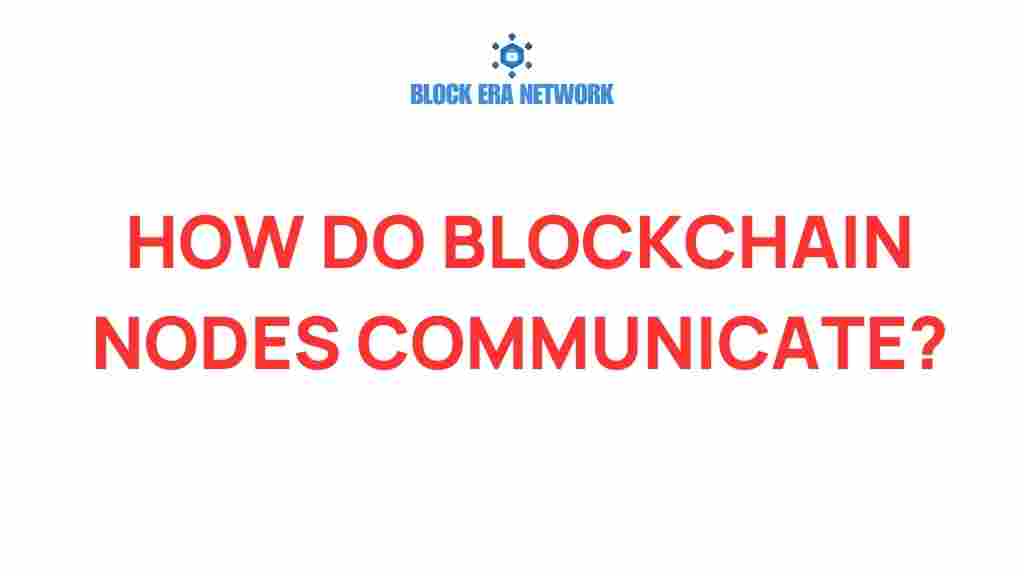Unraveling the Mysteries: How Blockchain Nodes Communicate
In the ever-evolving world of technology, blockchain nodes play a crucial role in the functionality and integrity of decentralized networks. Understanding how these nodes communicate is essential for anyone interested in blockchain technology, whether for investment, development, or simply to satisfy curiosity. In this article, we will delve into the intricacies of communication between blockchain nodes, exploring their significance in data transfer, the mechanisms of peer-to-peer networks, and their impact on network efficiency and consensus.
Let’s embark on this journey to demystify how blockchain architecture operates and why it matters in today’s digital landscape.
Understanding Blockchain Nodes
Before we can comprehend how blockchain nodes communicate, we need to define what these nodes are. In a blockchain network, a node is any active electronic device that maintains a copy of the blockchain and helps facilitate the communication and data transfer across the network. There are various types of nodes, including:
- Full Nodes: These nodes maintain a complete copy of the blockchain and validate transactions.
- Light Nodes: Also known as lightweight nodes, they do not store the full blockchain but rely on full nodes for information.
- Mining Nodes: These nodes contribute to the creation of new blocks through a process known as mining.
The Importance of Communication in Decentralized Networks
At the heart of any blockchain system is the need for effective communication among blockchain nodes. This communication is vital for several reasons:
- Data Integrity: Ensuring that all nodes have the same version of the blockchain helps maintain data integrity.
- Consensus Mechanism: Nodes must reach an agreement on the validity of transactions to prevent fraud and double-spending.
- Network Efficiency: Effective communication minimizes delays and ensures that transactions are processed quickly.
How Blockchain Nodes Communicate
Now that we understand the significance of communication in blockchain networks, let’s explore the actual process of how this communication takes place among blockchain nodes.
Step 1: Peer-to-Peer Networking
Blockchain operates on a peer-to-peer network architecture, meaning that each node communicates directly with others without a central authority. This decentralized approach enhances security and reduces the risk of a single point of failure.
In a traditional client-server model, clients rely on a server to provide them with information. However, in a peer-to-peer model:
- Each node can act as both a client and a server.
- Data is shared directly between nodes.
- The network can continue to function even if some nodes go offline.
Step 2: Data Transfer Protocols
To facilitate data transfer, blockchain nodes use specific protocols that dictate how data is packaged, transmitted, and received. Common protocols include:
- TCP/IP: The foundational protocol for most internet communications.
- UDP: Used for faster data transfer where speed is prioritized over accuracy.
- Custom Blockchain Protocols: Each blockchain may implement its own specialized protocols to suit its unique requirements.
Step 3: Broadcasting Transactions
When a transaction occurs, it is broadcasted to all connected nodes. Here’s how this works:
- The transaction is created and signed by the sender.
- The transaction data is sent to the node that the sender is currently operating.
- This node verifies the transaction and then broadcasts it to its peers.
- Each receiving node verifies the transaction according to its consensus rules.
- Once verified, the transaction is added to the node’s memory pool, awaiting inclusion in a new block.
Step 4: Achieving Consensus
Consensus is crucial in decentralized networks to ensure all nodes agree on the state of the blockchain. There are several consensus mechanisms, including:
- Proof of Work (PoW): Nodes compete to solve cryptographic puzzles. The first to solve it gets to add the new block to the blockchain.
- Proof of Stake (PoS): Nodes validate transactions based on the amount of cryptocurrency they hold and are willing to “stake” as collateral.
- Delegated Proof of Stake (DPoS): A small number of nodes are elected to validate transactions on behalf of the others.
Each of these mechanisms has its strengths and weaknesses, impacting network efficiency and security.
Troubleshooting Communication Issues Among Blockchain Nodes
Despite the robust nature of blockchain communication, issues can arise. Here are some common problems and troubleshooting tips:
Common Issues
- Network Latency: Delays in communication can occur due to network congestion or slow internet connections.
- Forks: A discrepancy between nodes on the blockchain can lead to forks, creating multiple versions of the blockchain.
- Node Outages: If a significant number of nodes go offline, it can affect the network’s ability to reach consensus.
Troubleshooting Tips
Here are some strategies to address these issues:
- Check Network Connections: Ensure that nodes are connected to the internet and are reachable by other nodes.
- Monitor Node Performance: Use monitoring tools to keep track of node performance and identify bottlenecks.
- Upgrade Node Software: Keeping the node software up-to-date can prevent compatibility issues.
- Participate in Community Forums: Engaging with the community can provide insights and solutions to common problems.
If you’re looking for more in-depth troubleshooting strategies, you can visit this helpful resource.
Conclusion
Understanding how blockchain nodes communicate is fundamental to grasping the principles of decentralized networks. From the initial data transfer to achieving consensus, each step plays a vital role in maintaining the integrity and efficiency of the blockchain. As technology continues to evolve, so will the methods of communication among nodes, leading to more robust and scalable blockchain solutions.
As we move forward in a world increasingly influenced by blockchain technology, mastering the intricacies of these blockchain nodes will be essential for developers, investors, and enthusiasts alike. Stay informed, participate in discussions, and continue exploring the fascinating world of blockchain technology.
This article is in the category Blockchain Basics and created by Block Era Network Team
